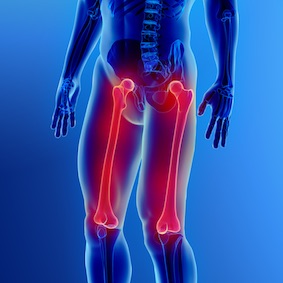What is a hamstring injury?
A hamstring injury happens when the tissue in one of the hamstrings is damaged by a strain or a tear to the tendons or large muscles at the back of the thigh. This damage usually occurs in sports; whilst sprinting, at an explosive start or suddenly stopping when you are mid run. But it can also result from over stretching while kicking or dancing or other sudden movements.
Common hamstring injury symptoms
A hamstring injury begins with a sudden, sharp pain in the back of the thigh that feels as if you’ve been stabbed or whipped. This specific pain is usually accompanied by a cramping sensation at the same time. Bending your leg becomes hard and walking (even slowly) is painful. Stretching the muscle or tightening it when bending your leg is painful as well. The area becomes stiff and within a couple of days you may notice bruising at the back of your thigh.
There are hamstring strains and hamstring tears. Typically, hamstring strain injuries are divided into three gradations:
Grade 1 – bending your leg feels uncomfortable but moving at walking pace hardly causes any pain. There is minimal swelling, but you might experience a tingling sensation. Only about one to five percent of muscle fibers becomes strained or damaged in this type of tear. It usually heals by itself after some rest.
Grade 2 – your hamstring feels tender to touch and there is visible bruising/swelling. Light exercise such as walking or cycling is painful and bending your knee causes a severely unpleasant sensation. You should see your physiotherapist if this is the case.
Grade 3 – walking is extremely painful, and you may need crutches for moving around. Not only do you feel a pain in your thigh, the surrounding muscles will be hurting as well. You will notice a large swelling on your thigh; a bruise may occur as well. Several muscle fibers may have been damaged. We strongly recommend seeing your GP or physiotherapist in order to diagnose the severity of the injury as well as discussing appropriate treatment. An operation may be necessary in case the muscles are torn completely.
If you are experiencing a persistent pain, please see your GP or physiotherapist first thing.
Hamstring injury incidence and who it affects
Hamstring injuries are most common in athletes. The biggest risk factor is playing a sport that requires speed, sprinting, making turns, accelerating, straining, etc. Other risk factors include a previous hamstring injury, insufficient warm-up, fatigue and muscle overload, leg length discrepancy or muscle strength imbalance between both legs, knee instability, tight hamstrings or a tilted pelvis.
Self-help for hamstring injury
To ensure a quick rehabilitation, physiotherapists advise to:
- Try and move your hamstring guided by the pain. If your injury hasn’t been diagnosed yet, it is recommended to avoid any movement that causes pain.
- Compress or bandage your thigh
- Apply cold packs to your hamstring for about 15 minutes. You could, for instance, use a closed, plastic bag filled with ice cubes and a little bit of water (ideally the temperature should be between 0 – 7 degrees Celsius). Repeat four to six times during the day. After one or two days you should gently resume activity, but it is of vital importance to avoid any kind of explosive or bouncy movements.
As soon as the worst of the swelling and pain have subsided, you can gently start doing strengthening exercises.
Book an appointment
Physiotherapy treatment for hamstring injuries
In order to create the most efficient treatment plan, it is essential to find out exactly what has caused the hamstring injury. Additionally, it is recommended to always consult a (sports) physiotherapist and ask for a diagnosis; this will lower the risk of hamstring injury recurrence. In some cases, the GP will prescribe painkillers or (minor) tranquilizers. Sometimes additional testing is necessary to determine the severity of the injury, using imaging or an MRI.
First, the focus should be on tissue healing, pain relief and relaxation. After this, rehabilitation should be the focal point. Recovery time varies from a couple of weeks to up to three months. In most cases you can return to sport specific activities in four to six weeks. After six or eight weeks you can usually resume competition.
Which other physical complaints does FysioCity treats?
Book an appointment
 NL
NL